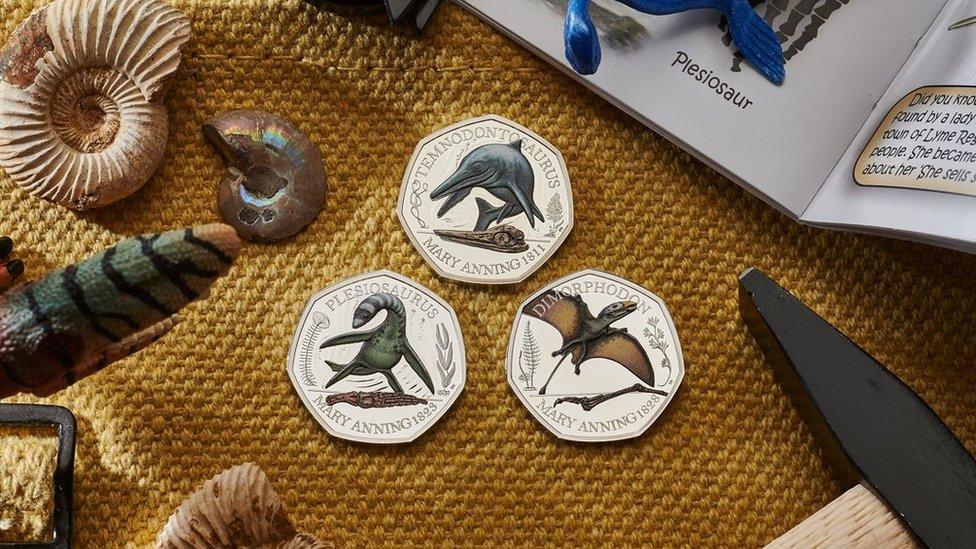Mary Anning: Jurassic creatures found by fossil hunter to appear on 50p coins
- Published
- comments

Some of the most terrifying creatures from the dinosaur era of the Jurassic are to feature on special 50p coins.
Sea-creatures, plesiosaurus and temnodontosaurus as well as flying dinosaur dimorphodon will appear on the coins.
The remains of the animals that lived more than 145 million years ago were all discovered by 19th-century fossil hunter, Mary Anning.
Anning was a palaeontologist - which is someone who studies dinosaurs - and made a series of fossil discoveries near her home in Lyme Regis in Dorset.
The story of palaeontologist Mary Anning - told in a beautiful sand animation.
Aged about 12, Mary and her brother Joseph made the first discovery of a temnodontosaurus in 1810.
Temnodontosaurus, which appears on one of the coins, was one of the largest and fiercest types of marine reptile from the Jurassic period.
Up to 10 metres long, it had the largest eye of any animal, about the size of a football, which it would use to look for food in the ocean that once covered southern Britain.
Its bite has been estimated as twice as strong as a large saltwater crocodile!
The Big Question: What's the difference between all the dinosaur periods?
The Royal Mint which produced the coins has collaborated with the Natural History Museum.
It's the second group of coins released from a series called Tales of the Earth. Last year the subject was dinosaurs, this year it's the Jurassic creatures discovered by Anning.
Clare Matterson, from the Natural History Museum, said: "The Mary Anning collection celebrates a pivotal figure in the understanding of palaeontology, important contributions to science that were rarely acknowledged in Mary's lifetime.
"It is fantastic to see Mary celebrated in such a special way in 2021."
Anning was often overlooked for her work when she was alive, but has been celebrated for her achievements much more recently.
In 2018 a group of rooms was named after her at the Natural History Museum in London and she was on the shortlist to be the face of the new 拢50 note, but missed out to wartime code-breaker Alan Turing.
Mary Anning would go fossil hunting with her dog Tray
Other coins from this collection will highlight Anning's discoveries of the plesiosaurus, another large marine reptile, and the dimorphodon, once thought to be a type of flying dinosaur, but scientists now think it only flew as a last resort.
Although the coins are 50p pieces, they're actually priced from 拢10 to 拢1,100 (for a gold version).
Each of the coins, the Royal Mint says, features "a scientifically accurate reconstruction of the creatures and the environment that they existed in".
- Published30 June 2020
- Published2 August 2018
